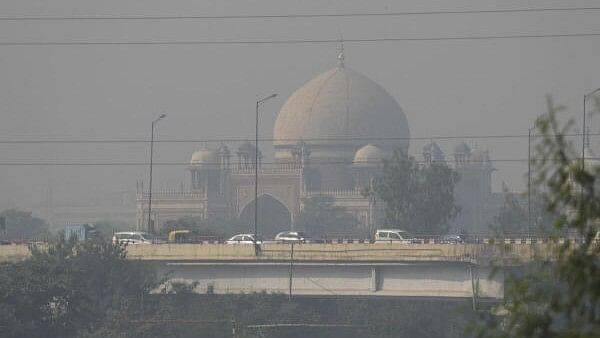
A view of the Humayun Tomb in New Delhi, Wednesday, October 30, 2024. A thick layer of smog enveloped the national capital on Wednesday morning as the air quality remained in the 'very poor' category.
Credit: PTI Photo
New Delhi: With a decrease in the number of farm fires, local pollutant sources continue to be the primary contributors to the deterioration of Delhi's air quality, accounting for 95 per cent of PM2.5 levels, according to a recent analysis.
The analysis by the Centre for Science and Environment (CSE) says Delhi's air quality has deteriorated from "poor" to "very poor", highlighting that local pollution sources, primarily vehicular emissions, are chiefly responsible for this decline.
The CSE's pre-Diwali and pre-winter assessment shows that farm fires contribute only about 4.44 per cent to Delhi's PM2.5 levels, while local pollution sources account for more than 95 per cent.
Notably, the transport sector is responsible for more than half of the pollution, followed by residential burning (13 per cent), industrial emissions (11 per cent) and construction activities (7 per cent), according to the analysis.
"This year, the air quality has worsened even though the contribution of farm fires has remained significantly lower than previous years," said Anumita Roychowdhury, executive director of research and advocacy at the CSE.
"The city can no longer deflect blame onto farm fires. We must urgently address local pollution sources," she added.
The analysis, covering PM2.5 levels from September 15 to October 28, indicates a concerning trend -- the PM2.5 levels reached 213 µg/m³ on October 23, coinciding with a temporary spike in farm-fire contributions.
However, the overall increase in the PM2.5 levels in October shows a 13-per cent rise compared to the same period last year, with a record number of "very poor" air quality days.
The CSE's study also identified a significant rise in traffic congestion across major roads in Delhi, exacerbating the pollution levels.
The average speed reduction during peak hours on weekdays was reported at 40.8 per event, leading to higher nitrogen dioxide (NO2) levels. The analysis revealed that congestion on the weekend before Diwali resulted in particularly elevated NO2 levels, peaking at 75 µg/m³ in the evening.
According to the report, 11 days of "very poor" air quality were recorded in October -- an increase from previous years -- while "good" air quality days drastically dropped from 11 in 2022 to just two this year.
As Delhi faces this pressing environmental crisis, experts assert that significant and immediate action is required to combat local pollution.
"Effective measures must be implemented to tackle emissions from vehicles, industry and other local sources," Roychowdhury said.